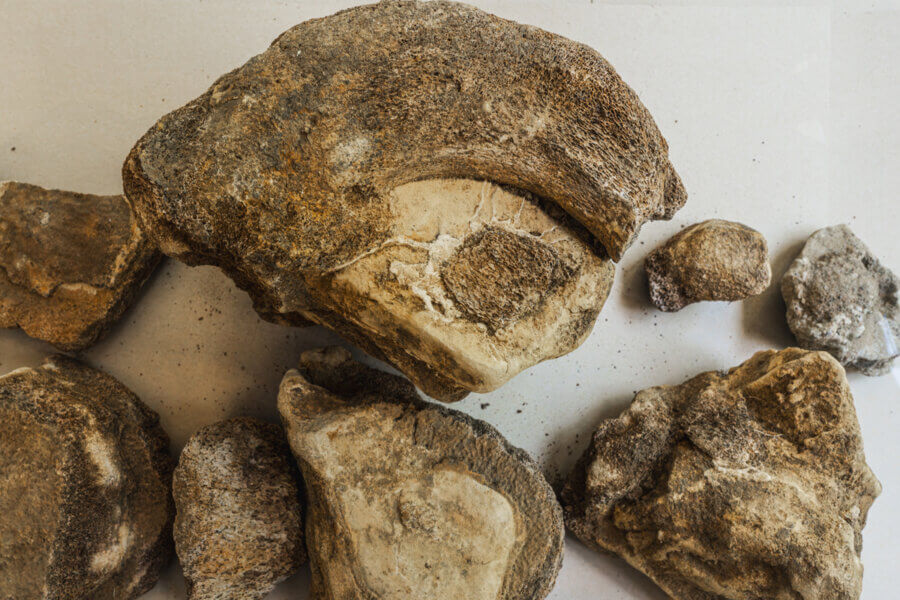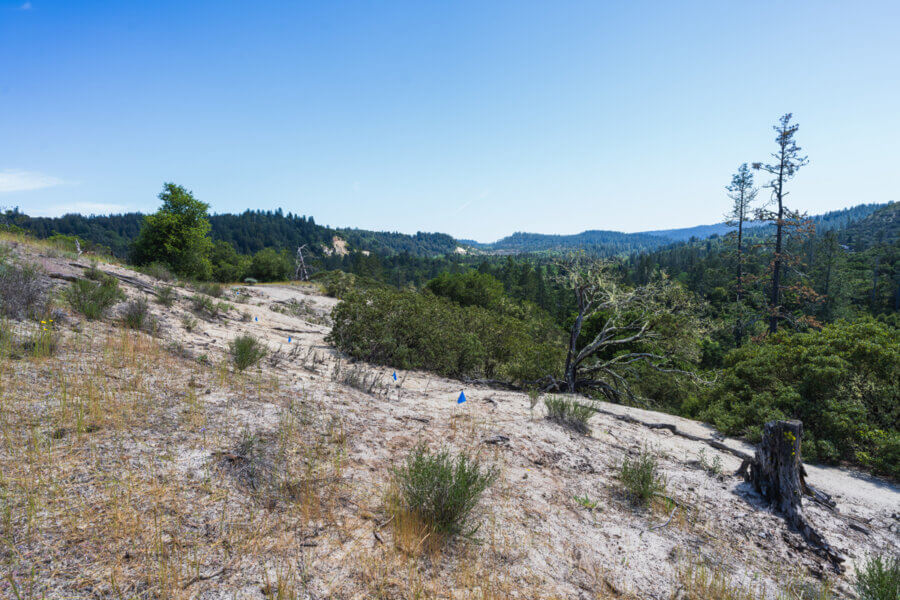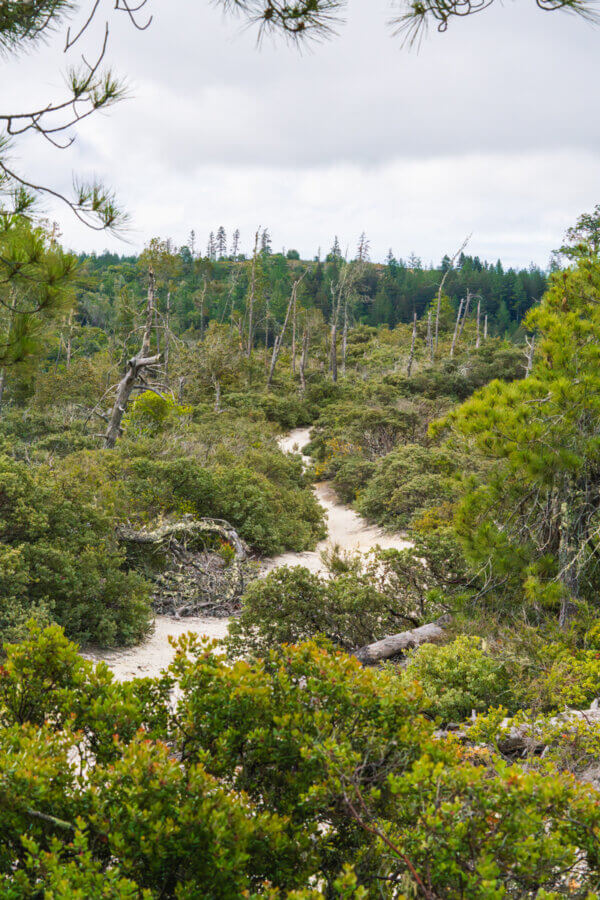Santa Cruz Sandhills
Nearly as ancient as redwoods—with fossil records dating back nearly to the dinosaurs—a 15-million year old sea floor emerges amongst the giants. Its Zayante soil, comprised of about 92% sand, can’t hold onto much nutrients or water. But these hot, dry pockets—starkly contrasting with their wet, dark redwood forest neighbors—support numerous species adapted to their extreme conditions, some of which aren't found anywhere else. The unfortunate similarity of sandhills and redwood habitats is that human impacts and climate change are leading to their decline. And like so many other things in the natural world, we are losing species faster than we can study them.
But in the case of the Santa Cruz sandhills and its inhabitants, no one can protect them better than you.
Harsh Habitat
It might look a bit barren, especially compared to the lush redwood forest next door. And unfortunately, that may have led to the mining, development, and decline of this ultra-rare habitat. But ecologist Dr. Jodi McGraw, who wrote the book—or rather the Sandhills Conservation and Management Plan—says while they may be smaller, she sees more species in the sandhills’ harsh conditions, including creatures from the redwoods and sometimes even the redwoods themselves, than she does in the forest over the decades she has studied the habitats.

Like the shark teeth and shell fossils found in its sand, the sediment found in Santa Cruz sandhills rose up through space and time, from the bottom of the ocean during the Miocene Epoch, about 23.03 to 5.333 million years ago. Of the approximately 6,000 acres of ancient sea floor that gave rise to Santa Cruz sandhills habitat, Dr. McGraw says about 3,000 acres remain. Making them even more rare, those 3,000 acres are actually two different sandhills communities: sandhills chaparral characterized by manzanitas, and sand parkland featuring disjunct populations of ponderosa pines found much lower than their usual 3,000-foot plus elevations.
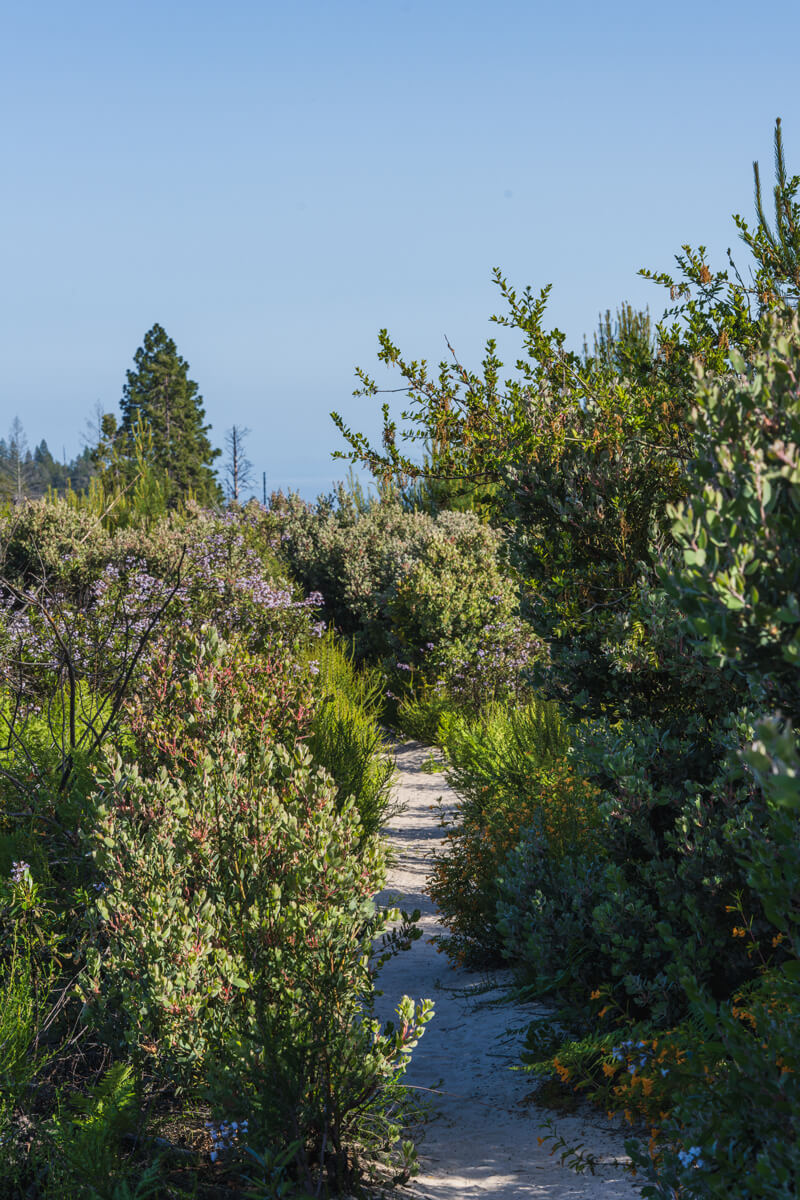


The sandy low-nutrient soil is sandhills plants' first line of defense. “This habitat is so extreme, other species can’t survive there,” explains James Maughn, a docent who guides hikes through protected Santa Cruz sandhills parkland habitat at Quail Hollow Ranch County Park. The plants that do grow here know how to survive with very little—little nutrients, little water, little shade, and very little stability in an easily shifting ground. These conditions are nearly opposite of those in the neighboring redwood forest habitat, but the water that slips through those sandy soils refills aquifers that give life to the redwoods and the rest of the ecosystem. Living in such close proximity, redwood and sandhill plant communities often share the same water, weather, and fire. And fire is sandhills plants’ next line of defense. Like coast redwoods, Santa Cruz sandhills plants are fire-adapted and need fire to survive and thrive.

Persistent Plants
Sandhills species have adapted to live without what most plants need and through what most plants can’t. Unique life grows from unique conditions. Three endangered plants live in the Santa Cruz sandhills and two others can’t be found anywhere else on Earth.
Ben Lomond Spineflower
One look at their pointy petals and you can guess where the Ben Lomond spineflower (Chorizanthe pungens var. hartwegiana) gets its name. But consider yourself lucky if you do see one of these federally-endangered wildflowers. They bloom from April through July but their small populations have only been found in the Santa Cruz mountains north of Santa Cruz. While they like some habitat disturbances such as a trail edge or gopher hole to open up space for them, invasive grasses making their way from nearby homes or past misguided attempts to “stabilize” the soil are a disturbance that further threatens their survival, explains Maughn. That being said, Henry Cowell State Park Interpreter Dylan McManus might consider himself, and the sandhills, incredibly lucky. At the end of May, McManus found a patch of Ben Lomond spineflower in Henry Cowell Redwoods State Park. And it may be a new patch that no one has documented before.
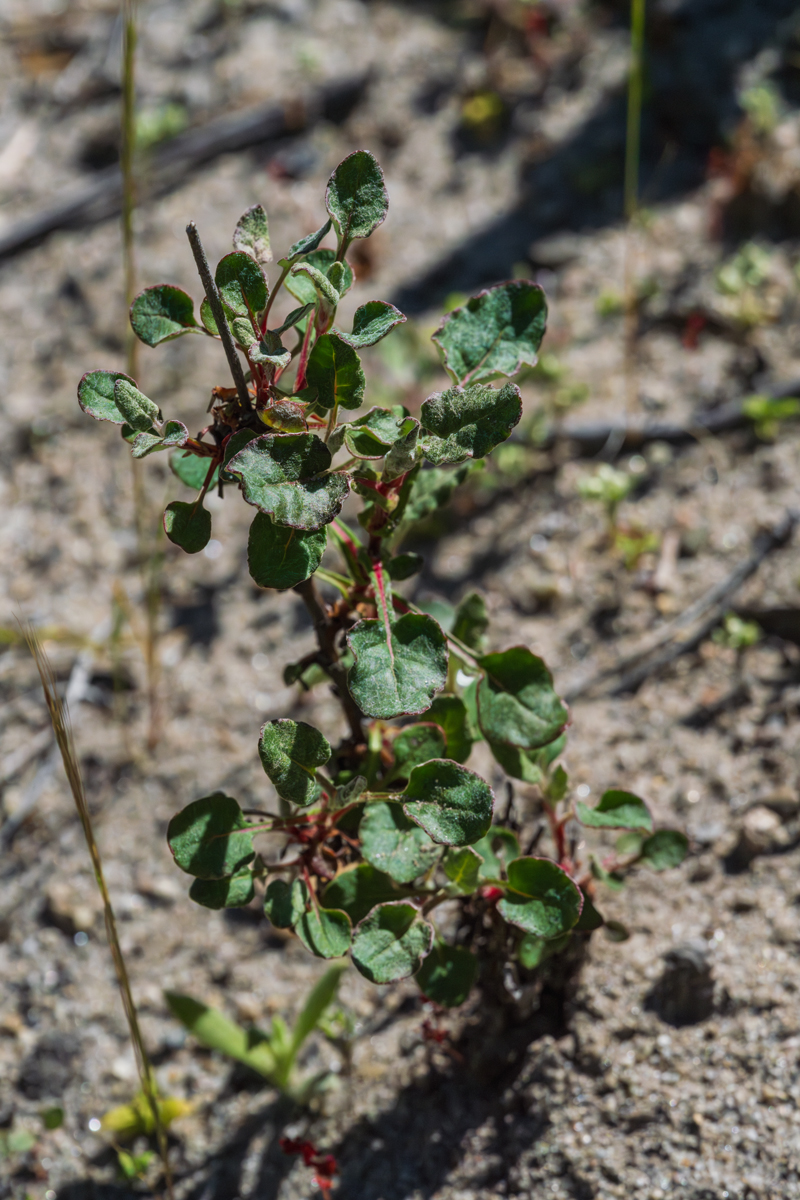
Ben Lomond Buckwheat
Nestled in openings in sandhills chaparral or beneath the ponderosa pines in sandhills parkland, Ben Lomond buckwheat (Eriogonum nudum var. decurrens) blooms support pollinators from June to October. Of the 25 likely butterfly and moth pollinators, Dr. McGraw said there may be a subspecies of dotted blue butterfly exclusive to the Santa Cruz sandhills. Unfortunately, despite Ben Lomond buckwheat’s already small numbers, small habitat, and the California Native Plant Society listing it as one of California’s most rare and endangered plants, it isn’t protected by federal or state laws. Although they are a fire adapted species, with so little known about these rare habitats and their inhabitants, Dr. McGraw says the challenge has shifted from reintroducing fire to sandhills plant communities in the previous decade to preventing too-frequent fire as a result of climate change. “Fires too often can potentially prevent even fire-adapted plants from persisting,” she notes.
Santa Cruz Wallflower
Of the sandhills’ endangered plants, the Santa Cruz wallflower (Erysimum teretifolium) is the most rare. “It takes multiple years to mature and flowers only once”, explains McManus. When it does bloom, its bright yellow petals typically appear from February to May in open areas and along trail edges. “Santa Cruz wallflowers don’t do well with competition,” Maughn shares, which is why populations at Quail Hollow and Bonny Doon benefit from active management to decrease erosion, pull invasive plants, and utilize fire to fend off encroaching plants and awaken seeds.
Santa Cruz Cypress
Seeds like those of the endangered Santa Cruz cypress (Hesperocyparis abramsiana var. abramsiana), are serotinous and open only from the heat of fire. Endemic to the Santa Cruz mountains, the Santa Cruz cypress can only be found on 350 acres, half of which is Santa Cruz sandhills habitat. The Santa Cruz cypress was once found in Henry Cowell State Park sandhills habitat but now is on the brink of extinction, McManus laments.
But all isn’t lost yet.
Some endemic species are surviving in surprising ways.
Santa Cruz County Monkeyflower
A rare plant found only in the county, Santa Cruz County monkeyflower (Mimulus rattanii ssp. decurtatus) isn’t a usual suspect in most places including rare sandhills habitat. However, McManus says he sees them at Henry Cowell Redwoods State Park growing in burned areas of sandhills chaparral where it blooms from May to July.
California Pinefoot
As harsh as the Santa Cruz sandhills seem for plants, a rare endemic plant thought only to grow in northern California was recently found in sandhills habitat for the first time. “Last season, a California pinefoot [Pityopus californicus] was discovered in the Santa Cruz sandhills at Henry Cowell. It was one of the most southern coastal documentations of the plant, a range expansion for the species,” McManus shares. Finding the species further south and in such a rare and specialized habitat is unexpected.

Bonny Doon Manzanita
Although Bonny Doon manzanitas (Arctostaphylos silvicola) have silvery leaves that reflect light and keep water in order to survive in the sandhills, they can’t survive fire. But they can flourish from it. Like Santa Cruz cypress, Bonny Doon manzanita relies on fire to create areas of open, bare soil and promote seed germination, McGraw notes. Fires in the last 20 years have helped to reestablish Bonny Doon manzanitas, many of which sprouted from seeds collected underground by their rodent custodians.

Waning Wildlife
Santa Cruz Kangaroo Rat
Rodents like the rare Santa Cruz kangaroo rat (Dipodomys venustus venustus) are considered a keystone species for the outsized impact they have on their habitat. Their contributions to storing seeds likely helped save the Bonny Doon manzanita they rely on for shoots to eat and shelter in its brush. Sadly, populations monitored since the 1980s started to disappear as off trail recreation crushed their burrows and eroded their fragile habitat. A bit like a kangaroo, their powerful hind legs help them move across the shifting sands but their short front legs wouldn’t be able to dig a burrow in anything harder than the loose Zayante soils of sandhills. It was looking bleak as Santa Cruz kangaroo rats were extirpated from all but one of their only known habitat locations. Henry Cowell Redwoods State Park had the last known population of Santa Cruz kangaroo rats in the sandhills. That is, until 2019, when they were rediscovered in Sierra Azul Open Space after 76 years. Mid Peninsula Open Space began work to enhance the habitat at Sierra Azul this spring and researchers are hoping this newfound population can help them gather enough data to get the imperiled Santa Cruz Kangaroo rat the Endangered Species Act protections before these special stewards are gone forever.
While the Santa Cruz kangaroo rats may not depend solely on the sandhills habitat for survival, other species do. Like little deserts in the rainforest, Santa Cruz sandhills have nurtured creatures like the desert-iconic the greater roadrunner and more specialized species, like the Mount Hermon June beetle, contributing to the incredible biodiversity of the Santa Cruz mountains. There are still species in the Santa Cruz sandhills that haven’t been described by science, and of those that have, two are endangered.


Zayante Band-Winged Grasshopper
Zayante band-winged grasshoppers (Trimerotropis infantilis) has been federally listed as an endangered species since 1997, but it's not for lack of skills. They can only fly a few feet, but that’s pretty good by grasshopper standards, and when they fly they produce a buzzing sound that helps them evade predators. The challenge is, they are currently only known to live in Santa Cruz sandhills parkland habitat—the rarest of the rare with approximately 600 acres of suitable habitat remaining. And without fire to help hold them at bay, both native and non-native plants are moving in and changing the habitat with shade and leaf litter, which might sound harmless but it decreases both the imperiled grasshoppers and their habitat. McManus reports Zayante band-winged grasshopper populations are very small and you’re unlikely to see one in Henry Cowell Redwoods State Park but your best chance may be during their flight season from May to October, with peak flight activity between July and August.
Mount Hermon June Beetle
Their fellow endangered sandhills insect, the Mount Hermon June beetle (Polyphylla barbata) faces a few more challenges than the Zayante band-winged grasshopper. Mount Hermon June beetles spend most of their lives as grubs, enriching the rare Zayante soil underground. Despite their humble and crucial role, they’re often viewed as pests by those who encounter them. “It's really hard to get people excited about beetles,” Maughn laughs. Those who might lend the endangered species some compassion could still easily confuse it with the common ten-lined beetle. And while disappearing habitat threatens their survival, so does leaving it. Mount Hermon June beetles are attracted to light and water which can draw them from their protected habitat into nearby yards treated with pesticides and into pools—they’re not swimmers. Unsuspecting neighbors may not even realize they’ve found an endangered species.

Of course not all species that benefit from these rare habitats are endemic or endangered. Wildlife like bobcats, hummingbirds, and acorn woodpeckers that shelter in the redwood forest are known to seek food in the Santa Cruz sandhills. “Species utilize both habitats for a variety of reasons,” Dr. McGraw says. Even redwoods themselves can be found enjoying drainages that keep their roots wet in the sandhills, she points out, like those growing near Eagle Creek in Henry Cowell Redwoods State Park. “But banana slugs probably steer clear,” Dr. McGraw laughs. And the sandhills bring a bit of the desert to the redwoods as well.
The sandhills provide habitat for wildlife from hotter drier habitats that might not otherwise be in the Santa Cruz mountains. Like the California whiptail lizard, (Aspidoscelis tigris munda) which has a need for speed and enjoys the Santa Cruz sandhills warm, open, sands where they can bury themselves and run down their prey while hunting. But some of these species are also feeling the impacts of our presence. The greater roadrunner (Geococcyx californianus) was seen in the sandhills until they were unfortunately hunted down by domestic cats living nearby in 1964. Invasive ants also living in homes nearby are making their way into the sandhills and outcompeting the native ants the Blainville's horned lizards (Phrynosoma blainvillii)—still recovering from a century of exploitation being sold as pets and varnish-coated tourist souvenirs—eat there.

Saving Sandhills
Santa Cruz sandhills habitat is not only extraordinarily unique—complementing the redwood forests and adding tremendous biodiversity to the Santa Cruz mountain region—it’s also extraordinarily fragile. “We’re still learning about this community, but the learning window is closing and it's important for us to steward it before it disappears,” McManus says. The good news? The second longest contiguous stretch of Santa Cruz sandhills habitat left on Earth is protected at Henry Cowell Redwoods State Park. But the struggle to save it is far from over.
“When you add hiking, biking and horseback riding to sandhills, the landscape changes at an alarming rate”

The trail in this second largest contiguous stretch of sandhills follows the edge of a restricted area, allowing visitors to enjoy the fragile area from the perimeter with minimal impact to the sensitive habitat and its inhabitants. But sadly some visitors are loving the sandhills to death by going off trail, making their own trails, and tearing out trail signage that helps other visitors stay on trail. “The trail system (in the sandhills extension) can be confusing due to the fact that illegal and new trails are continually being developed within the closed area, and the park faces an uphill battle to install infrastructure that isn't vandalized," McManus shares. And while some may think going off trail isn’t that big of a deal, in sandhills, it's one of the biggest. “This isn’t sandstone like Moab,” McGraw explains. “This crumbles at your touch. Sandhills erode incredibly fast,” she continues. When you add hiking, biking and horseback riding to sandhills, the landscape changes at an alarming rate, McManus agrees.
Luckily, there are several ways you can recreate responsibly in and learn more about how to protect Santa Cruz sandhills.
Where to Go
While many wildflowers bloom in spring, sandhills plant communities will begin flowering with manzanitas in the winter with wildflowers blossoming in the spring and often lasting through summer.
Guided Hikes
- In the summer, McManus says Henry Cowell Redwoods State Park leads hikes in the sandhills at 9am on the second Saturday every month. Check out their schedule for the next hike.
- April is the only time of year the public can visit Quail Hollow’s ultra-rare sandhills parkland habitat. It’s only accessible by guided hikes every Sunday. Spaces are limited and fill up fast, so Maughn recommends visitors check for openings in February or March.

Trails
If you can’t snag a space on one of the highly sought after guided hikes, here are some of the best trails to admire the fragile fleeting beauty of Santa Cruz sandhills habitat:
Bonny Doon Ecological Reserve
Dr. McGraw recommends the Silverleaf and Wallflower loops to traverse sandhills habitat.
Henry Cowell Redwoods State Park
McManus suggests hiking to the Observation Deck, which has both easy and moderate version, for a trip through and a great view of sandhills.
Quail Hollow Ranch County Park
Maughn recommends the Sunset Trail that features sandhills chaparral along the way.
How to Help
The Sandhills Conservation and Management Plan just turned 20 this May and Dr. McGraw is looking at updating it with the latest science and priorities. In the 20 years since the plan was created, there has been heartbreak as populations have disappeared and delight as new populations have been found. Hope is not lost—Santa Cruz sandhills greatest hope for survival could be you.
You can help by:
Staying on Trails
Staying on trails and adhering to trail closures is the best way to enjoy nature responsibly but especially crucial in such rare, fragile habitats as Santa Cruz sandhills, Dr. McGraw and McManus urge. "If we don't steward this landscape and it continues on its current path of degradation, then over time species' densities and distributions will change and the unique biodiversity we experience when recreating responsibly in this ecosystem will also begin to change,” McManus explains. Please be mindful of your impact on and movement of the sand. These soils crumble and are displaced easily, Maughn adds.

It’s estimated that two-thirds of Santa Cruz sandhills habitat is unprotected and privately-owned. If you live near these incredibly rare ecosystems, here are more ways you can help:
Volunteer
Removing invasive plants can be hard work but it's one of the most helpful ways to help care for endangered Santa Cruz sandhills habitat. Look for volunteer opportunities at parks with sandhills habitat like Quail Hollow Ranch County Park and Henry Cowell Redwoods State Park.
Pets
When living near sandhills, keeping pets inside and on leash where appropriate can have an enormous positive impact for sandhills species.
Lights
If you are a fan of bugs, you can help protect them by turning off unnecessary outdoor lights that draw them away from safer habitat. If you’re not a fan of bugs, you can see less of them by turning off unnecessary lights outside that attract them to your home. It’s a win-win!
Inform
Not everyone knows how rare, fragile, and unique Santa Cruz sandhills are. Share with others what you know about this habitat and these incredible species and let them know how they can help. Henry Cowell Redwoods State Park has lots of great resources for sharing and learning more and McManus is working on more:

More to Explore
- Visit some of our favorite trails to enjoy sandhills wildflowers responsibly in our Wildflowers After Wildfire Guide
- Read about the many habitats, including sandhills, protected at Henry Cowell Redwoods State Park
- Read more about the diverse wildlife of the Santa Cruz mountains




